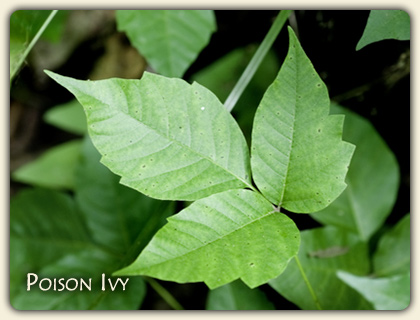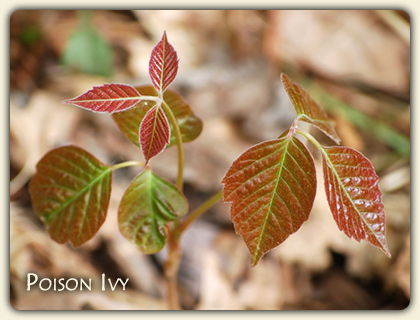The Mighty Poison Ivy Plant
Dispel the myths and learn the facts. Learn to identify the poison ivy plant, prevention, treatment, and discover a holistic perspective on poison ivy. Take the time to learn about this potentially hazardous plant before you run into it!

How to identify the poison ivy plant
To the untrained eye, the poison ivy plant (Toxicodendron radicans) can often be difficult to notice as you're walking around in the woods. However, by doing some studying right now you can shorten your learning curve for identifying it in the field. With practice over time, you'll get really good at spotting it when you are out and about. Eventually, you can even develop an intuitive sense for it, as many of us have. Let's take a look at the different parts of the poison ivy plant.
Leaves
The leaves are one of the best ways to identify poison ivy. Poison ivy has compound leaves, which means that each leaf is comprised of three leaflets. The leaflets are most commonly toothed or lobed, but can also be smooth-edged. Poison ivy leaves are alternate, meaning that they alternate growing on the right side, then the left side, of the main vine. The middle leaflet has a longer stem than the two side ones. The leaves are bigger at the base of the plant. From spring to summer you can find their leaves shiny green. In the fall their leaves turn reddish orange. The oil, urushiol, contained in this plant is what gives the leaves a glossy, waxy appearance. Remember,
Thus, the famous saying "leaves of three, let it be."
Flowers and berries
The flowers are five grayish, white, yellow or green petals growing in clusters. They are 1/8 inch to 1/2 inch in diameter. The poison ivy plant flowers from May to July. Berries form in summer, and are small, 1/4 inch round, hard white or cream-colored balls drooping from the leaf axils.
Overall appearance
The poison ivy plant is a transformer and can take many appearances. It can be a hairy vine climbing up trees and other vertical objects up to 100 feet tall. It can grow as a ground cover up just 2 feet tall, and it can also grow as an erect bushy shrub up to 4 feet tall. Don't depend on it's overall appearance alone for identification.
Beyond identification - other poison ivy facts
Beyond basic identification, there are many poison ivy facts that will help you better understand this plant if you ever encounter it. For example, the urushiol oil is what gives your body the skin rash. The urushiol oil can stay active on any surface, including dead plants, garden tools, fishing poles, and more for up to five years. So, that means you can actually get poison ivy rash without coming into contact with the plant.
If you do contract the rash, it could show up in as early as four hours on your skin. It can also take as long as 48 hours to break out. You might get a simple red rash, your skin could streak, your eyes could swell shut or your skin could bubble and blister. Everybody's skin is different!
Where can you expect to find this plant? Poison ivy is common and grows in fields, thickets, woods, near fences, in disturbed areas, on the sides of trails and just about anywhere across the US, Canada and Mexico.
The poison ivy's relatives, eastern and western poison oaks, are all in the same family. The poison oak plant look very similar to the poison ivy plant. The two big differences are:
- Poison oak leaflets are rounder than poison ivy, suggesting a white oak leaf.
- Poison oak branches are smooth, without hairs.
- Poison oak only grows up to six feet tall.
It's a good idea to know all of the Toxicodendron species!
I have seen many people react to a poison ivy rash as if a sudden quarantine is in order, when in fact none of these plants are contagious. Not from one person to another, from one body part to another or even from pets or other animals to another. New rashes show up due to the fact that the body has thicker skin in places and thinner skin in others. Rashes surface on thinner skin first. Consider all this the good news!
By knowing the annual life cycle of the poison ivy plant you'll know when the oils are most active. In the spring the plant is pollinating. When summer rolls around it's producing seeds. Birds are eating the fruits and spreading seeds in the fall and the plant is more dormant in the winter months. Thus, the oil is most active in the height of summer.
Prevention
Besides confidently identifying the poison ivy plant and knowing its annual life cycle, there are some other tips that can help you prevent getting poison ivy rash and running into this plant precariously!
- Wear long-sleeved shirts and pants, close-toed shoes when you are out in the woods or moving through foliage.
- Teach your friends and family how to recognize poison ivy as well. You don't want a poison ivy epidemic!
- Know that even the bare twigs and branches are toxic during their dormancy.
The all-time best method for prevention of poison ivy contact or rash is to actually get out there and practice identifying it and respecting its place in nature. Like any hazard, the best approach for learning to live with it is to learn the facts about it, and gain true awareness of it through practice. Practicing avoidance is only asking for trouble, one way or another.
Treatment
If you suspect you've contracted poison ivy rash, the first thing to do is to clean the exposed skin with rubbing alcohol. Then wash it with water. Then and only then bathe in warm water and soap and apply everything that may have touched poison ivy with rubbing alcohol as well. Do this as swiftly as possibly, ideally within 10 - 15 minutes of being exposed to urushiol oil, otherwise the oil could stay on your skin or seep in and produce a rash. Some people say that you can clean the exposed areas of your skin with vinegar, mineral spirits or commercial cleanser and that any of these will remove the urushiol oil. Others have reported that bathing four times a day with dish soap is particularly effective. Wash your clothes and shoes once you've taken them all off to bathe and remove the oil from your skin.
There are many things that will dry out the urushiol oil on your skin. Taking vitamin C, applying Calamine lotion, Aveeno, baking soda paste, apple cider vinegar, or tea tree oil directly onto the affected areas can dry it out. Soak in salt water, an oatmeal bath, baking soda, a hot tub, or do a quick swim in a chlorinated pool to dry it out. It has been reported that even tomato juice baths eliminate poison ivy immediately. Once the poison ivy is gone you can moisturize your skin once again.
If you get a severe case of poison ivy I suggest evaluating whether you want further support from a doctor. Severe cases of poison ivy can sometimes mean bacterial skin infections. Ouch!
For more thorough information on treatment of poison ivy go to our other article Powerful Poison Ivy Treatment.

Poison Ivy as Medicine - Why does the poison ivy plant exist?
Just as conventional or alternative medicines can bring us healing and recovery in times of illness, poison ivy offers us medicine by expanding our awareness, humbling us, and healing a disconnected relationship with nature. The old paradigm says that poison ivy is an enemy and something we need to eradicate at all costs. Is that it?
There is a new (actually much, much older) paradigm that speaks to poison ivy being a gift. Yes, a gift. With the understanding of medicine in mind, poison ivy can be thought of as a warrior plant and a protector species. Poison ivy boldly says, "Don't step here." It can have a powerful impact on our awareness as we venture out into forests and other places. We are given the opportunity to practice becoming more observant of our surroundings and move carefully through the woods we're exploring without invading its space.
Like many hazards in nature, poison ivy has given me the gift of awareness. As I move through the natural world, my awareness is constantly active, taking in information from around me and filtering for any sign of poison ivy. Over time, this process begins to become automated, simply happening in the background of my awareness. A greater intuitive awareness then emerges, to the extent of my being able to literally sense its presence with my skin prior to observing any sign of it with my eyes. This is like a sixth sense. It is amazing to experience.
The cool thing is that this level of awareness is available to us all. I'm not special in any way, I have simply developed my awareness over time. It's just learning a new skill set, like learning to ride a bike or drive a car. This happen with poison ivy, as well as countless other features of the natural world. Developing this level of relationship with nature is a deeply moving experience, and affects everything about me and the way I move in the world. Much can be said here. This is the level of awareness our earth based ancestors had, this level of awareness is our birthright, and this is the awareness I want to see our children have. This is what we facilitate at Twin Eagles Wilderness School.
The poison ivy plant is a gift.
The extreme opposite of this would be that if you completely stay away from the poison ivy plant by never going outside and exploring, you'll miss out on the opportunity to touch the beauty of nature, and discover what you are capable of. What a shame that would be.
It's easy for us as humans to isolate poison ivy and only consider it from a superficial perspective. But poison ivy also has a relationship with other wildlife besides humans. Deer browse on the foliage. Bears and birds eat the berries, all with no adverse effects. It is a bigger world out there than just us humans.
Additional resources
There's a lot of information and resources available on the poison ivy plant. Many contain myths and indignation about this plant. I highly recommend you take a look at the following books which largely keep to the identification or hold a different perspective on poison ivy altogether.
- A Field Guide to Venomous Animals and Poisonous Plants by Roger Caras, Steven Foster and Roger Tory Peterson
- Attacked by Poison Ivy: A Psychological Understanding by Ann Belford Ulanov
- The Poison Oak and Poison Ivy Survival Guide by Sandra J. Baker
When you are in the woods on your next adventure and you come across poison ivy, remember it's an opportunity to stop and take stock of your awareness. You can ask yourself, "Where was my attention when I came into this leafy patch of poison ivy?" And like the poison ivy, "What are my protective mechanisms and when am I pulling them out the most?" If you've just walked into poison ivy, you can see it as either an unfortunate run-in or an opportunity to be humbled and learn to increase your awareness. Then the true gift comes in connecting with your place.
Interested in being personally mentored on a transformational journey of deep connection to nature, community, and self?
Check out the Twin Eagles Wilderness Immersion Program.
comments powered by Disqus
Return from Poison Ivy Plant to Online Herbal Remedies Advice
Return from Poison Ivy Plant to Wilderness Survival (homepage)
Track Us